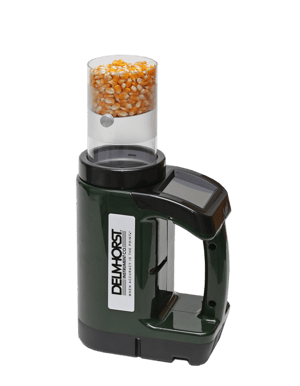Timing the harvest is one of the most crucial aspects of growing any crop—and grains such as wheat and rice are no exception. Harvesting crops when they’re at their peak quality helps to ensure the best nutritive value and keeps buyers coming back for more. A poorly-timed harvest, on the other hand, can result in a loss of quality or even spoilage that results in product waste and lost revenue.
But, how can farmers be sure that they’re harvesting their grain at peak quality? There are many different indicators for whether or not grain is ready to harvest, but the one that most people forget about is the moisture content (%MC) of the grain.
Harvesting grain while it’s at its ideal moisture content can help maximize the grain’s overall nutritive value and quality, as well as prevent spoilage from having too much moisture.
But, how can you be sure that your grain is at its ideal moisture content for harvesting? You can do so by using a grain moisture meter to test the moisture content of your grain crops.
Using a Moisture Meter for Grain
 To get the most valuable and accurate information regarding the moisture content of grain, it’s important to use a moisture meter that is specifically calibrated for testing grain. This means that the meter has a grain reading scale calibrated for accuracy in testing grain moisture.
To get the most valuable and accurate information regarding the moisture content of grain, it’s important to use a moisture meter that is specifically calibrated for testing grain. This means that the meter has a grain reading scale calibrated for accuracy in testing grain moisture.
While other types of moisture meters might provide a qualitative assessment of grain moisture, it will be a “rough guess” rather than an accurate moisture measurement.
Some grain moisture meters, like the D999-FR, have a built-in dump cell for testing grain moisture. This moisture meter for grain makes it relatively easy to make sure that you have the right size grain sample for testing—simply fill the cup, level it off, and empty the cup into the dump cell.
However, different types of grain have different physical characteristics that might affect the accuracy of a moisture test. To account for this, Delmhorst’s 999-series grain moisture meters have a built-in species correction feature for more than 250 types of grain. When testing grain moisture, you can program the meter for the appropriate type of grain prior to taking a moisture content measurement—the meter will automatically make corrections to the readings it takes from there.
Going Beyond Improving the Harvest
Aside from optimizing the timing of the harvest by diligently checking the moisture content of grain crops to make sure they’re at their ideal %MC for harvest, there is another use for a moisture meter for grain: to verify that grain is at the right moisture content for long-term storage or sale.
For many grain crops, the ideal moisture content for harvest is not the same as the ideal moisture content for storage and shipment. Instead, grain crops often need to be dried to a certain level to ensure that they do not spoil during shipment.
A handheld grain moisture meter can be invaluable for testing grain as it dries, helping you to make sure that you know exactly when the grain is at its ideal moisture content for storage or sale. Being able to repeatedly test grain as it dries is important because it helps you to avoid over-drying grain and giving away free dry weight at the time of sale while avoiding the risk of spoilage.
Need more help and info for using a moisture meter for grain? Contact the team here at Delmhorst to learn more, or download the grain infographic at the link below:

Comments